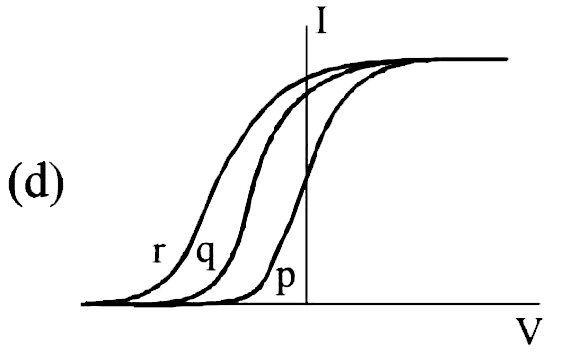Photoelectric effect experiments are performed using three different metal plates p, qandr having work function = respectively. A light beam containing wavelengths of 550 mm, 450 nm and 350 nm with equal intensities illuminates each of the plates. The correct I-V graph for the experiment is (see Fig.) [Take hc=1240 eV nm]




The correct Answer is:A
For phototlectric emisssion, the wavelength of the incident readiation must be less than the fut-off wavelength of the metal given by For metal is p,q and r, the cut-off wavelengths are
Hence metal plate p emits photoelectrons for all the given radiations, metal plate q emits photoelectrons for radiation of wavelengths 450 m and metal plates r emits photoelectrons only for wavelength 350 mm. Therefore photoelectric current is maximum for metal p and minimum for r, i.e.,
Similar Questions
Photoelectric effect experiments are performed using three different metal plates p,q andr having work function ϕp=2.0eV,ϕe=2.5eVandϕr=3.0eV respectively A light beam containing wavelength of 550nm,450nm and 350nm with equal intensities illuminates each of the plates . The correct I−V graph for the experiment is [Take hc = 1240 eV nm]
View SolutionThe graph between 1/λ and stopping potential ( V ) of three metals having work functions ϕ1,ϕ2 and ϕ3 in an experiment of photoelectric effect is plotted as shwon in the figure. Which of the following statement (s) is / are correct ? [Here λ is the wavelength of incident ray ].

View Solution
Knowledge Check
photoelectric affect experiments are performer using ther different medal plates p,q andr having work functionphi_(p) = 2.0 eV, phi_(e) = 2.5 eVandphi_(r) = 3.0 eVrespectivelyAlightbeamconta∈∈gwave≤n>hof550nm , 450 nmand350nm withequal∫ensitiesilluminateseachoftheplate.Thecorrect1 -Vgraphfortheexperimentis [Take hc = 1240 eV nm]
A B
B C
C D
D
Photoelectric effect experiments are performed using three different metal plates p,q and r having work functions ϕp=2.0eV,andphi_q=2.5eV andphi_(tau) =3eV and wavelengths of 550 nm,550nm, and 350 nm with equal intensities , illuminates each of the plates . The correct I - V graph for the experiment is (Take hc = 1240 eV nm)
A B
B C
C D
D
A light beam of interest 3.01×10−3Wm−2 is incident normally on the square -sapped metal surface of side 1 cm and with work function 2 eV . The intensity of light is equal distributed among the three constituents' wavelength , 400 nm, 550 nm and 650 nm. Each photon emits one electron without any loss in the energy.
Choose the correct option from the following regarding the photoelectric emission.AElectrons emitted due to light of wavelength 400 nm onlyBElectrons emitted due to light of wavelength 650 nm onlyCElectrons emitted due to light of wavelengths 440 nm and 550 nm onlyDElectrons emitted due to light of wavelengths 550 nm and 650 nm only
(a) In a photoelectric experiment, the collector plate is at 2.0V with respect to the emitter plate made of copper (ϕ=4.5eV) . The emitter is illuminated by a source of monochromatic light of wavelength 200 nm. Find minimum and maximum kinetic energy of the photoelectrons reaching the collector.
(b) A small piece of cesium metal (ϕ=1.9eV) is kept a distance of 20 cm from a large metal plate having a charge density of 8.85×10−9C/m2 on the surface facing the cesium piece. A monochromatic light of wavelength 400 nm is incident on the cesium piece. Find minimum and the maximum kinetic energy of the photoelectrons reaching the large metal plate. Neglect any change in the electric field due to the presence of small piece of cesium.
View SolutionA 60 W bulb is placed at a distance of 4 m from you. The bulb is emtting light of wavelength 600 nm uniformly in all directions. In 0.1 s, how many photons enter your eye if the pupil of the eye is having a diameter of 2mm? [take hc=1240eV−nm]
View SolutionThe figure below shows a vaccum tube containing electrodes made of different metals, 1 and 2 whose work functions are ϕ1 and ϕ2 The electrodes are illuminated simultaneously. The maximum kinetic energy of photoelectrons reaching plate 2 is 1 eV and maximum kinetic energy of photoelectrons reaching plate 1 is 3 eV. Assume that photoelectron emitted from either plate do not interact with each other ϕ1=1.5 eV and ϕ2=0.7 eV. Find wavelength (in nm) of the electromagnetic wave used

View SolutionIn a photoelectric experiment, the collector plate is at 2.0 V with respect to the emitter plate made of copper '(phi = 4.5)'. The emitter is illuminated by a source of monochromatic light of wavelength 200nm. Find the minimum and maximum kinetic energy of the photoelectrons reaching the collector.
View SolutionA 60 W bulb is placed at a distance of 4 m from you. The bulb is emtting light of wavelength 600 nm uniformly in all directions. In 0.1 s, how many photons enter your eye if the pupil of the eye is having a diameter of 2mm? [take hc=1240eV−nm]
View Solution
